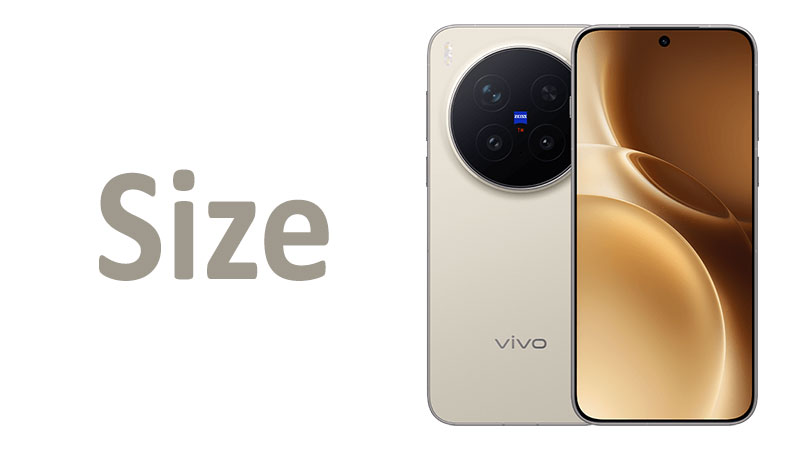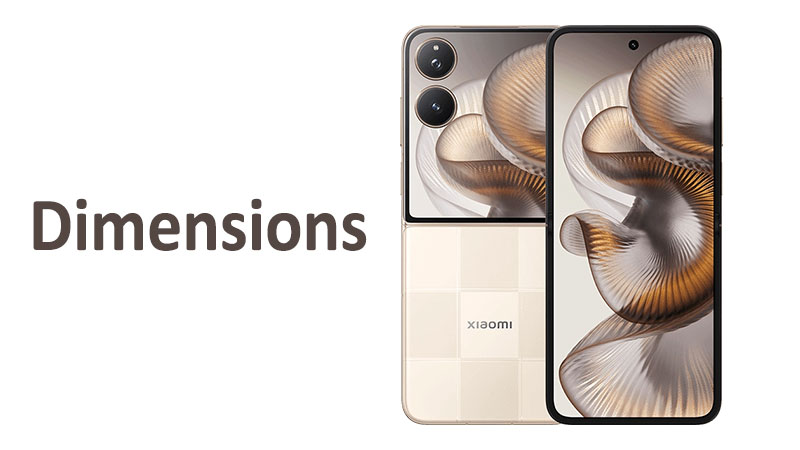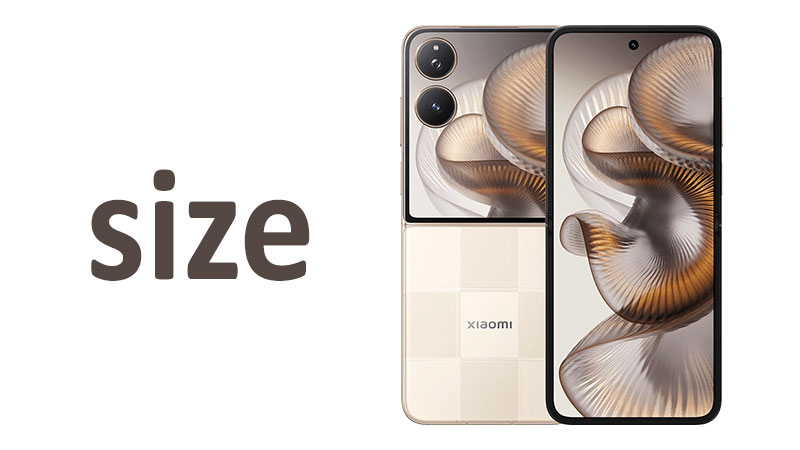The vivo X300 Pro Size and dimensions are crucial factors for buyer satisfaction. A flagship phone’s physical form dictates comfort, usability, and portability. Vivo designed the X300 Pro to balance a vast, immersive display with manageable ergonomics. The physical dimensions tell a detailed story about engineering and design priorities. We will explore the precise measurements of the vivo X300 Pro in depth. This analysis covers the screen, height, width, and thickness. It also provides important comparisons to key market rivals. Understanding the size helps potential buyers assess daily handling and one-handed use.
The Immersive Display: 6.78 inches of Screen Real Estate
The vivo X300 Pro boasts a large 6.78 inch screen size. This expansive panel dominates the front surface of the device. This size choice aligns perfectly with current premium smartphone trends. Users demand maximum screen area for content consumption. A larger screen significantly enhances viewing movies and playing immersive games. The total screen surface area is approximately 111.5 cm2. This generous space accommodates complex applications and detailed visuals easily.
This large display area is ideal for professional and personal use. Working on spreadsheets or editing documents becomes far more comfortable. The added space reduces the need for constant scrolling. It also improves productivity during split-screen multitasking. Consumers prioritize screen size for its direct impact on their digital life. Therefore, the 6.78 inch measurement is a primary selling point for the vivo X300 Pro.
Specialized Comparison: Screen Size Trend
The 6.78 inch display keeps pace with other industry giants. It is marginally larger than many standard flagships, offering a slight edge. For instance, some direct competitors settle for 6.7 inches. The X300 Pro’s size is notably larger than compact options, such as those near 6.1 inches. However, it avoids the unwieldy size of the true screen giants. This measurement represents the sweet spot for maximum display without excessive bulk.
The previous generation vivo X200 Pro likely had a slightly smaller screen. Moving to 6.78 inches ensures a modern, cutting-edge feel. This increase satisfies users upgrading from older, smaller flagships. It provides an immediate, noticeable visual enhancement. This size is quickly becoming the new industry standard for high-end devices.
Pros and Cons of a Large Screen
The primary pro of the 6.78 inch display is the superior media experience. Videos are more engaging and text is highly readable. Gamers benefit from the expansive field of view. The large surface area also aids touch precision and input accuracy.
The main con relates to one-handed use and portability. Reaching the top corner of the screen requires significant finger stretching. This can sometimes feel awkward. The large glass surface also increases the risk of damage if dropped. Users need to handle the phone carefully. It is not the best choice for those seeking a truly pocketable device.
Buyer’s Consideration: Media First
A reader should understand the 6.78 inch size commitment. This phone caters primarily to media consumers and power users. If your daily tasks involve video editing or extensive reading, this screen is an asset. However, if small size and ease of single-handed operation are paramount, alternatives may be better. This screen size demands two hands for comfortable, full navigation.
The Exterior Dimensions: 161.2 mm Height Analysis
The total height of the vivo X300 Pro measures 161.2 mm, or 6.35 inches. This vertical measurement defines the overall length of the device. It plays a significant role in how the phone fits into pockets and small bags. The height is determined by the screen size, bezel thickness, and internal component placement.
The 161.2 mm height is considered average for a phone with a 6.78 inch screen. Modern engineering minimizes the non-screen area above and below the display. This allows for a massive screen within a relatively compact frame. The phone feels elongated, which is visually appealing. It also offers more space for the internal battery and camera modules.
Specialized Comparison: Vertical Reach
Flagships with similar screen sizes often land within 160 mm to 163 mm in height. The X300 Pro sits comfortably in the middle of this range. This suggests efficient use of the vertical space. Some rivals with slightly smaller screens might have similar heights due to thicker bezels. The X300 Pro optimizes the ratio of screen to chassis height effectively.
Older generations, like the X200 Pro, might have been 160 mm or less. The small increase reflects the slight screen expansion. However, the difference is often less than a millimeter. This shows that manufacturers are pushing screen size without dramatically increasing phone length.
Pros and Cons of 161.2 mm Height
The main pro is the ability to house the large screen and a substantial battery. A taller phone usually allows for better component spacing. This aids thermal management during heavy use. The height also lends a premium, cinematic feel to the phone.
The primary con relates to accessibility and pocketability. Phones taller than 160 mm can protrude from certain shirt or pants pockets. This increases the risk of the phone falling out. Furthermore, the length exacerbates the difficulty of reaching the very top edge of the screen.
Buyer’s Consideration: Pocket Fit
Buyers should check how the 6.35 inch height affects their daily routine. If you wear tight clothing or rely on small pockets, measure them first. This phone requires deeper pockets for comfortable and secure carrying. Users who carry their phone in a jacket pocket or purse will find the size manageable. It is a tall phone, designed for a modern user who values screen space over compact storage.
Grip and Width: 75.5 mm Across
The width of the vivo X300 Pro is 75.5 mm, or 2.97 inches. This horizontal measurement is arguably the most critical dimension for comfortable one-handed grip. A narrower phone is easier to hold securely. A wider phone, however, offers a broader display surface. The 75.5 mm width is a careful design compromise.
This specific width is considered standard for phones with displays approaching 6.8 inches. Maintaining a narrower profile helps offset the phone’s considerable height. The goal is to keep the thumb reach distance reasonable. The phone’s overall girth is managed well by this width. This dimension contributes significantly to the phone’s overall feel in the hand.
Specialized Comparison: Hand Comfort
Phones with widths exceeding 78 mm often become genuinely difficult for one-handed use. The 75.5 mm width of the X300 Pro remains within the comfortable range for most adult hands. It is slightly narrower than some other devices featuring comparable screen sizes. This small difference improves the security of the grip.
In comparison, compact flagships may measure 71 mm or 72 mm wide. The X300 Pro is significantly wider than these smaller phones. This confirms its status as a large device. The ergonomic design must rely on curved edges to maintain comfort at this width.
Pros and Cons of 75.5 mm Width
The major pro is the broad typing experience. The extra width makes the on-screen keyboard significantly easier to use. This reduces typos during rapid text entry. The width also directly supports the excellent stereo speaker separation. This is important for media consumption.
The principal con is the stretch involved for full one-handed use. Users with smaller hands will find their thumb cannot cross the entire screen width. They will likely need to engage two hands for comfortable text selection. A protective case might add another 2 mm to the width. This further complicates the grip.
Buyer’s Consideration: Grip Security
A potential buyer should seriously consider the 75.5 mm width. If you prioritize secure one-handed holding, try to feel a similarly sized device. Using a slim case is recommended to maintain the narrowest possible profile. The phone’s width optimizes screen space. However, it requires a confident grip from the user.
Sleekness and Ergonomics: The 8 mm Thickness
The thickness of the vivo X300 Pro is a surprisingly slim 8 mm, or 0.31 inches. This measurement is remarkably thin for a flagship device. It is especially thin considering the advanced internal components. The phone houses a large battery and a complex camera module. Achieving 8 mm thickness is a testament to efficient engineering and component stacking.
The slim profile enhances the premium feel of the device. It slides easily into and out of pockets. A thin phone also feels better in the hand than a thick, brick-like device. The 8 mm measurement contributes significantly to the overall aesthetic appeal. Thinness remains a key factor in perceived flagship quality.
Specialized Comparison: Flagship Thickness
Many competing flagships with large batteries hover between 8.5 mm and 9.0 mm thick. The X300 Pro is notably thinner than these rivals. This slight difference makes a massive impact on the feel. It suggests Vivo successfully balanced battery size and design aesthetics. The thinness is a clear advantage over some competitors.
However, some extreme thinness champions might reach 7.8 mm or less. The X300 Pro achieves an excellent balance without going to the extreme. Extreme thinness can sometimes compromise battery life or structural integrity. The 8 mm profile seems to be a safe, sleek, and optimized figure.
Pros and Cons of 8 mm Thickness
The most evident pro is the ergonomic comfort. A thin phone is pleasant to hold for long periods. It feels sleek and less bulky than thicker devices. The slim profile also minimizes the total volume of the phone. This helps with portability.
The main con is the potential for camera module protrusion. The advanced sensors likely require extra space. This space must extend beyond the 8 mm body thickness. This creates a camera bump or ‘island’ on the back. The bump causes the phone to wobble when placed flat on a table. Buyers should consider this wobble factor.
Buyer’s Consideration: Handling and Aesthetics
A buyer focused on aesthetics will appreciate the 8 mm profile. It is a visually attractive and sleek device. However, you must accept the trade-off with the camera bump. Using a case can solve the wobble issue. The case will, however, increase the overall thickness to approximately 9.5 mm or more. Choose a case that is thin but protective.
Bezel Optimization: 91.6% Screen-to-Body Ratio
The vivo X300 Pro achieves an impressive ∼91.6% screen-to-body ratio. This metric measures the percentage of the phone’s front surface occupied by the display. A high ratio indicates minimal bezels around the screen. This ratio is a strong indicator of modern, efficient design.
A 91.6% ratio is considered top-tier in the current smartphone market. It signifies a near edge-to-edge viewing experience. The bezels are incredibly slim, often less than 1 mm thick. This minimal framing maximizes the visual impact of the 6.78 inch display. It makes the content appear to float on the phone’s surface.
Specialized Comparison: Visual Immersion
A 91.6% ratio is competitive with the very best flagship devices available. Many standard flagships remain around 88% to 90%. The extra percentage points on the X300 Pro enhance the feeling of immersion significantly. The visual difference is noticeable when watching full-screen videos. The phone nearly eliminates the black borders surrounding the content.
This ratio is a massive leap from phones of just a few years ago. Older devices often had screen-to-body ratios below 85%. The thinness of the bezels requires advanced display and bonding technology. It confirms the Pro model’s cutting-edge status.
Pros and Cons of a High Ratio
The major pro is the unparalleled viewing experience. The phone feels like one solid sheet of glass. This maximizes the utility of the large screen size. A higher ratio also makes the phone visually striking and modern. This is a critical factor for premium device status.
The cons mainly relate to accidental screen touches. With such thin bezels, the user’s palm might accidentally register touches on the edge of the display. Software must be highly optimized to detect and ignore these unintentional inputs. Screen replacement costs may also be higher due to the complex, near-zero bezel design.
Buyer’s Consideration: Handling Sensitivity
Buyers should be aware of the increased handling sensitivity. Ensure the operating system, likely Funtouch, has excellent palm rejection software. This prevents frustrating accidental inputs during one-handed use. The high screen-to-body ratio is fantastic for aesthetics. However, it requires careful interaction to avoid edge touches. Users should look for reviews confirming successful palm rejection.
Conclusion: An Informed Decision on the X300 Pro Size
The vivo X300 Pro Size and dimensions place it firmly in the premium large-format category. The phone dimensions are 161.2×75.5×8 mm (6.35×2.97×0.31 in). It features a massive 6.78 inch screen with a superb 91.6% screen-to-body ratio.
This size profile is an intentional design choice. It prioritizes screen real estate and visual immersion over pocketability. The thin 8 mm thickness provides a sleek feel and excellent ergonomics. However, the 75.5 mm width necessitates two hands for full screen navigation.
The X300 Pro is an ideal choice for media enthusiasts, mobile gamers, and productivity users. These individuals prioritize the massive, edge-to-edge display. They will gladly accept the slightly larger form factor. Buyers seeking a compact, easily pocketable device should look elsewhere. For the user who wants maximum screen and minimal bezel, the X300 Pro dimensions deliver outstanding results. It strikes an excellent balance between screen size and overall manageable girth.
Frequently Asked Questions (FAQ)
1. Is the vivo X300 Pro considered a large phone?
Yes, the 6.78 inch screen and 161.2 mm height classify it as a large-format flagship phone.
2. How thin is the vivo X300 Pro?
The phone measures 8 mm (0.31 inches) thick. This is considered very slim for a device in its class.
3. Will the phone fit easily in a standard jeans pocket?
The height of 161.2 mm means the phone will likely fit in most adult jeans pockets. However, it might protrude from smaller pockets.
4. What does the 91.6% screen-to-body ratio mean?
It means the display occupies 91.6% of the entire front surface. This indicates extremely thin bezels for maximum viewing area.
5. Is it possible to use the vivo X300 Pro with only one hand?
One-handed use is challenging due to the 75.5 mm width. Most users will require two hands to navigate the entire screen comfortably.



